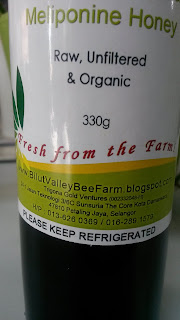Honey is loved and consumed by people all over the world, as an alternative to sugar in their beverage and confectionery, as a condiment to their sweets and desserts, as a beauty aid, and for many, for their medicinal and healing properties.
As meliponine honey contains high amounts of antioxidants, in fact the highest for phenolic acid, it's almost a panacea for ailments and diseases, even chronic ones as proven by extensive clinical and medical reserach. As such, it is our fervent wish to offer a premium brand of organic, raw honey that is hygienically harvested, stored and packed.
Good Beekeeping Practices (GBP) are strictly adhered to. Unlike in the United States where they have established a standard known as Best Management Practices for Beekeeping,
our GBP is not a standard
regulated by any authority, simply because there is none in
existence in Malaysia. We had created a reference for ourselves, one which we impose on
ourselves.
 |
| No bare hands touching the insides of the toppings, please. We've seen enough of dirty fingernails of beekeepers in other bee farms. But the good side of seeing that, it had actually led us to be desirous of running our own farm. |
 |
| The bottles of honey are quickly placed in a cooler bag. This is to avoid the heat from causing the honey to ferment which will make it frothy and taste rancid. Fermentation is inevitable when there is more than 18% moisture in the honey. Keeping the bottles in the cooler bag will reduce the process to the minimum during transportation from the farm to the clinic where the honey is bottled. | |
|
 |
| The bag is secured and pests like ants are kept safely away. Keeping them in this bag also keeps the sunlight from damaging the delicate honey. We want to be sure that the honey stays in it's raw form as closely as possible to ensure all the enzymes are kept intact. |
For storage purposes, we use new, cleaned and sterlised bottles. They
are prepared the same way as the bottles that are used for packaging
which we had shown on
Part 1
of this post. Call us snooty if you want but as we said earlier, we
won't compromise on hygiene so we do not want to use recycled containers
for this purpose. It has been known that some honey samples taken for an analysis had shown traces of foreign and hazardous matter such as lead, and it was suspected that the source was the storage container.
 |
| New, clean and fresh bottles for storing our honey that you take home. |
 |
| Tools used to harvest the honey as well as those used in our meliponiculturing and beescaping activities are washed and sterilised regularly with a cleaning agent and an antiseptic. We choose Melamagic and Soluguard by The Melaleuca Company for these purposes as they are organic. This is one of the important procedures required under our own GBP | | |
It is a seemingly simple procedure but it can prevent the
hives, toppings, plants and the whole farm in general from being
infested by fungus, parasites, and all other organisms that may destroy
the bees, the brood cells or the plants. If this happens, God forbid, it will be nothing less than a devastation. This is one of the many valuable lessons learnt at the Beescape Workshop.
Once the honey is brought back from the farm, it is kept in a chiller for not less than 48 hours before it
is packed in amber botlles. When they reach our consumers, they are to
be kept in refrigeration or in a cool place.
There is no heating
or dehydration process using heat as this may destroy precious enzymes
in the honey. This is the true definition of raw, unfiltered honey. This
is the honey we want you to experience and enjoy.






